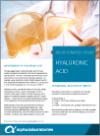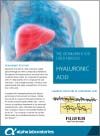Hyaluronic Acid
The biomarker for Liver Fibrosis.
Hyaluronic Acid (HA) is an excellent biomarker for serially assessing liver cirrhosis.
HA is an extracellular matrix (ECM) protein that is synthesised in hepatic stellate cells (HSC) and degraded by sinusoidal endothelial cells (LSEC). Serum concentration of HA is consistent with stages of fibrosis and also decreases with a response to interferon therapy in patients with chronic Hepatitis C infection.
Applications
As liver function is compromised by fibrotic disease serum levels of HA rise.
Initial increases in serum HA may be the result of enhanced production by activated hepatic stellate cells.
Later, as cirrhosis becomes established, there is impairment of the sinusoidal endothelial cells responsible for removing HA from circulation.
Percutaneous liver biopsy is considered to be the gold standard for diagnosing and staging liver disease.
However biopsy is:
Invasive – risk of pain, bleeding, even death
Costly
Limited – small sample sizes, potential inter-observer errors.
Biochemical biomarkers such as hyaluronic acid offer a reliable, non-invasive alternative for both initial diagnosis and
onward patient monitoring.
Benefits
Determine plasma or serum Hyaluronic acid levels with the Wako latex agglutination method. This assay shows excellent analytical characteristics that make it appropriate for clinical practice.
The test is now easily automated and can be performed on most routine clinical chemistry analysers. For example, using a Beckman Coulter AU640 analyser Guéchot et al. measured the imprecision from within-run CV to be up to 2.12% and from between-run CV to be up to 4.08%.
The assay is supplied in the form of latex reagents along with separate kits for calibrators and controls. All are provided with an open-vial stability of 30 days at 4 C.

